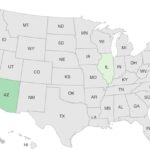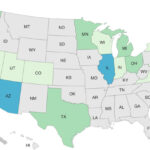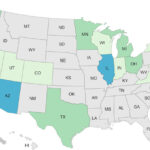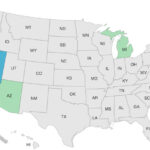Mariscos Bahia recalls fish that is associated with a Salmonella Litchfield outbreak that has sickened at least 33 people in three states according to the FDA. Thirteen people have been hospitalized in this outbreak because they are so sick. The patient case count has not changed since the initial outbreak investigation was announced last week. The illnesses are linked to fresh, raw salmon supplied to restaurants in California and Arizona by Mariscos Bahia, Inc. The case count is: Arizona (11), California (21), and Illinois (1). The product was sold in Arizona and California, but it may have been sold to restaurants in other states. The recalled fish, that was shipped beginning on June 14, 2022, includes: Fresh Salmon Fillet Fresh Deep Skin Salmon Fillet Fresh Salmon … [Read more...]
Salmonella Litchfield Outbreak Linked to Mariscos Bahia Salmon
A Salmonella Litchfield outbreak linked to Mariscos Bahia fresh raw salmon products has been announced by the Centers for Disease Control and Prevention (CDC). At least 33 people in three states are sick, and 13 people have been hospitalized. The salmon was supplied to restaurants in two cities in California and Arizona by that company. The fish sold to restaurants by Mariscos Bahia, Inc. include salmon, tuna, Chilean sea bass, swordfish, and halibut. The restaurants are located in Pico Rivera, California and Phoenix, Arizona. This fish was not sold directly to consumers in grocery stores or markets. The case count by state is: California (21), Arizona (11), and Illinois (1). Illness onset dates range from June 14, 2022 to September 18, 2022. The patient age range is from age … [Read more...]
Fratelli Beretta Antipasto Salmonella Outbreak is Number 3 of 2021
The Fratelli Beretta antipasto Salmonella outbreak is the number three multistate food poisoning outbreak of 2021. There were two types of Salmonella in this outbreak: Infantis and Typhimurium. Forty people in 17 states were sickened, and 12 people were hospitalized. Twenty-six people were sickened with Salmonella Typhimurium, and 14 were sickened with Salmonella Infantis. The patient case count by state was: Arizona (5), California (8), Colorado (1), Illinois (5), Indiana (1), Maryland (1), Michigan (2), Minnesota (2), Nevada (1), New York (1), Ohio (3), Oregon (2), Texas (3), Utah (1), Virginia (1), Washington (2), and Wisconsin (1). Illness onset dates ranged from May 9, 2021 to August 16, 2021. The patient age range was from one year to 91 years. Fratelli Beretta uncured … [Read more...]
Fratelli Beretta Antipasto Salmonella Outbreak Ends With 40 Sick
The Fratelli Beretta Antipasto Salmonella outbreak has ended with 40 people sick in 17 states, according to the Centers for Disease Control and Prevention (CDC). Twelve people were hospitalized because they were so sick. There were two types of Salmonella in this outbreak: Salmonella Typhimurium and Salmonella Infantis. The case count by state is: Arizona (5), California (8), Colorado (1), Illinois (5), Indiana (1), Maryland (1), Michigan (2), Minnesota (2), Nevada (1), New York (1), Ohio (3), Oregon (2), Texas (3), Utah (1), Virginia (1), Washington (2), and Wisconsin (1). That is an increase of four more patients since the last update in late August, 2021. Illness onset dates ranged from May 9, 2021 to August 16, 2021. The patient age range is from one year to 91 years. The … [Read more...]
FDA Releases Romaine Lettuce Sampling Findings From Yuma, AZ
The FDA is releasing results from its romaine lettuce sampling findings from the Yuma, Arizona area. Lettuce from that area was linked to a deadly E .coli O157:H7 outbreak that killed five and sickened 210 people. Ninety-six people were hospitalized because they were so ill. And twenty-seven patients developed hemolytic uremic syndrome (HUS), a type of kidney failure that is a complication of an E. coli infection. The FDA collected and tested romaine lettuce from commercial coolers in Yuma County, Arizona during February and March 2021. The lettuce was tested for Shiga toxin-producing E. coli (STEC) bacteria, specifically enterohemorrhagic E. coli (EHEC), and Salmonella. This sampling program was part of the agency's surveillance after several multistate E. coli O157:H7 outbreaks … [Read more...]
Two Salami Prosciutto Salmonella Outbreaks Sicken 36 in 17 States
Two salami prosciutto Salmonella outbreaks have sickened at least 36 people in 17 states, according to the Centers for Disease Control and Prevention (CDC). These new outbreaks were just announced a few hours ago. These Italian-style meats are eaten unheated and are often served in antipasto or charcuterie assortments. Twelve people have been hospitalized. No recall has been issued. The overall case count by state is: Arizona (5), California (7), Colorado (1), Illinois (4), Indiana (1), Maryland (1), Michigan (2), Minnesota (2), Nevada (1), New York (1), Ohio (3), Oregon (1), Texas (2), Utah (1), Virginia (1), Washington (2), and Wisconsin (1). Of this total, 23 people are part of a Salmonella Typhimurium outbreak and 13 people are part of a Salmonella Infantis outbreak. In the … [Read more...]
CDC Weighs in on Reopened Salmonella Weltevreden Shrimp Outbreak
The CDC is weighing in on the reopened Salmonella Weltevreden shrimp outbreak that has sickened at least nine people in four states. Three people are hospitalized because they are so sick. That is an increase of three new illnesses, one new hospitalization, and two new states since the last update in July 2021. This investigation was closed, but was reopened when more ill persons were discovered. The case counts by state are: Arizona (2), Michigan (2), Nevada (4), and Rhode Island (1). Illness onset dates range from February 26. 2021 to July 17, 2021. The patient age range is from 30 to 80 years. Of six people who gave information to investigators, three have been hospitalized. At least one of the newly diagnosed patients ate frozen cooked shrimp supplied by Avanti Frozen foods … [Read more...]
Shrimp Salmonella Outbreak Continues With Three More Sickened
The FDA says that the shrimp Salmonella outbreak continues because three more patients have been identified. Now nine people are sick. In addition, two more states, Michigan and Rhode Island, have been added. The outbreak was declared over on July 21, 2021. Avanti Frozen Foods issued a recall for their frozen cooked shrimp on June 25, 2021. The case count by state is now Nevada (4), Michigan (2), Rhode Island (1), and Arizona (2). The last illness onset date is July 20, 2021. In the previous investigation notice, which was on July 21, 2021, the last illness onset date was April 25, 2021. Since the shrimp originally identified as the cause of this outbreak should no longer be available for sale, that means people may still have the shrimp in their home freezers. In addition, at … [Read more...]
Salmonella Weltevreden Shrimp Outbreak Ends With Six Ill
The Salmonella Weltevreden shrimp outbreak has ended with six people sick in two states, according to an update by the Centers for Disease Control and Prevention (CDC). This outbreak was linked to a recalled product: shrimp imported from India by Avanti Frozen Foods. The patient case count is: Arizona (2) and Nevada (4). This case count has not increased since the initial investigation report was released almost a month ago. The patient age range is from 30 to 80 years of age. Of five people who gave information about their condition to the CDC, two were hospitalized, for a hospitalization rate of 40%, which is high for a Salmonella outbreak. And of those interviewed, all said they ate shrimp the week before they got sick. Epidemiologic, traceback, and laboratory evidence … [Read more...]
Cooked Shrimp Salmonella Outbreak: How is Seafood Contaminated?
The cooked shrimp Salmonella outbreak announced by the FDA last week is not the first time seafood has been linked to a Salmonella outbreak. But does seafood naturally contain Salmonella bacteria, like chickens and sometimes beef? If not, how is seafood contaminated with this pathogen? Seafood such as shrimp and tuna do not naturally carry Salmonella bacteria, unlike poultry and other warm-blooded animals, according to a 2005 National Library of Medicine study published in the Journal of Food Protection. That study states, "Salmonella is not part of the natural flora of the shrimp culture environment nor is it inherently present in shrimp grow-out ponds. The occurrence of Salmonella bacteria in shrimp from aquaculture operations is related to the concentration of fecal bacteria in … [Read more...]














